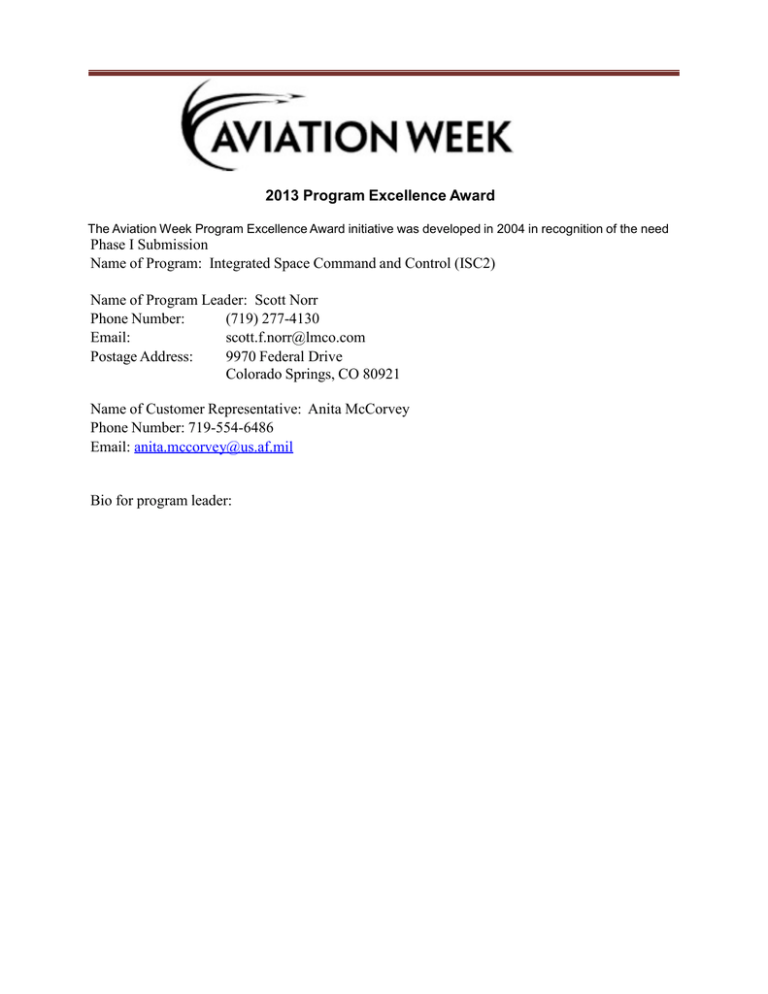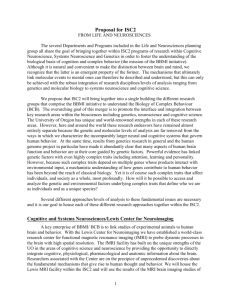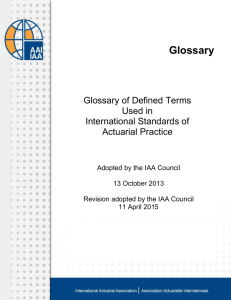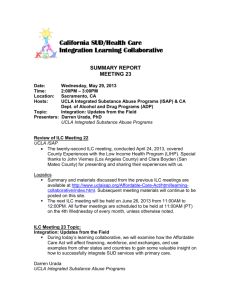Sub Sys Sustain_LMCO_ISC2
advertisement

2013 Program Excellence Award The Aviation Week Program Excellence Award initiative was developed in 2004 in recognition of the need Phase I Submission Name of Program: Integrated Space Command and Control (ISC2) Name of Program Leader: Scott Norr Phone Number: (719) 277-4130 Email: scott.f.norr@lmco.com Postage Address: 9970 Federal Drive Colorado Springs, CO 80921 Name of Customer Representative: Anita McCorvey Phone Number: 719-554-6486 Email: anita.mccorvey@us.af.mil Bio for program leader: BIOGRAPHY (.5 pages) Scott Norr is a Program Management Institute certified Program Management Professional with over 26 years of Engineering and Program Management experience. His education includes a Bachelors Degree in Mechanical Engineering as well as a Masters of Engineering Management from Brigham Young University. Scott began his professional career with AlliedSignal Engines (later Honeywell) in Phoenix, Arizona as a Mechanical Engineer on a large turbine engine program for the US Army. He filled several roles of increasing responsibility within Systems Engineering, Test and Design; ultimately becoming the Engineering Director for the Honeywell/Rolls-Royce partnership. He then became the Program Manager for the Undersea Vehicles, Launch Vehicles and Space products for Honeywell's Engine Systems and Accessories Division and was responsible for various aircraft development and production projects. Later he became the Program Manager for Boeing and Airbus aircraft supporting the ongoing production of all Starters, Valves and Actuators for Boeing commercial aircraft as well as developing the Engine Thrust Reversal System for the Airbus A380. Scott then became the Program Manager for Honeywell's Satellite Control Network Contract for the US Air Force Satellite Control Network in Colorado Springs, CO. His responsibilities included development and sustainment of the Air Force Tracking Station Scheduling, Orbital Analysis and Recording systems. Scott joined Lockheed Martin's Integrated Space Command and Control (ISC2), Air and Missile Command and Control Program. In this role, he was responsible for managing multiple interdependent projects to support NORAD/NORTHCOM and USSTRATCOM situational awareness for air and missile warning and reporting. Scott is currently the ISC2 Program Manager for Operations, Maintenance and Sustainment Program. He is responsible for management of day-to-day Operations, Techology Refresh and Software Upgrade projects totaling over $120M of annual Sales. The program employs over 550 individuals supporting critical US Air Force Strategic Forces for NORAD/NORTHCOM and USSTRATCOM. Scott completed the Lockheed Martin Program Manager Development Program in 2010, and was recognized with the Lockheed Martin President’s Quarterly Performance Award in 2012. Scott exemplifies full spectrum leadership principles in leading the ISC2 contract. Phase I Program Narrative - 1 Overview The Integrated Space Command and Control (ISC2) Contract is large, complex, and dynamic in nature. The Lockheed Martin led team was recently awarded a continuation of the current contract with options through 2015 by the US Air Force Life Cycle Management Center (AFLCMC). The contract provides the foundation for Air, Missile, and Space Defense mission integrity and continuity of operations. It is valued at ~$120M on an annual basis, providing mission operations, maintenance, and sustainment (OM&S) to ensure the National Defense of the United States of America. ISC2 provides the United States Air Force’s system-of-systems architecture implementation for North American Aerospace Defense Command (NORAD), US Northern Command (USNORTHCOM), US Strategic Command (USSTRATCOM), and other users. It provides a common, interoperable command and control infrastructure that gives commanders flexibility to handle growing mission responsibilities. The ISC2 program evolved the Battle Management Command and Control infrastructure from 37 legacy stove-piped systems to a modern, flexible architecture. ISC2 designed, developed, tested, and deployed the system, achieving Operational Acceptance of the architecture in 2006. Now in full operations, the contract provides all IT and communications support to Cheyenne Mountain Air Force Station (CMAFS), the mission hub for NORAD, USSTRATCOM, and NORTHCOM. In CMAFS, Lockheed Martin operates one of the largest technical control facilities in the US Department of Defense and won the Defense Information Systems Agency (DISA) Category IV Facility of the Year award for 4 straight years. Contract support includes OM&S of secure and non-secure telephone systems, networks, help desk, OM&S of mission data up to the highest classification levels, and inside/outside plant operations. ISC2 supports the Space Situational Awareness and Space Defense Missions at Vandenberg Air Force Base (VAFB). The Lockheed Martin led contractor team is responsible for operating, maintaining, and sustaining the Mission System of record for the General Perturbation space catalog. The team also develops and sustains the software and applications that maintain the Special Perturbation, or high accuracy, catalog. The team includes Orbital Safety Analysts that use the catalog data to provide conjunction screening runs and associated date to NASA and other owner operators. Since relocating the system from CMAFS to VAFB in 2007, ISC2 has remained committed to the mission and has worked closely with the Air Force to mitigate risks to the legacy mission systems through Technology Refresh, Technology Insertion, and helping to bridge the gap for future migration efforts. The number one priority of the ISC2 Contract is to maintain the integrity of the Air, Missile Warning, and Space Missions while focusing on innovation to minimize cost and maximize war fighter capability. ISC2 achieves this by maintaining mission availability levels that meet extremely difficult, classified performance requirements. The team uses system availability metrics to determine where common issues cause outages, analyzes root causes, and then makes recommendations to enhance system reliability and mission performance. ISC2 collects and analyzes systems availability metrics for all missions to maintain, enhance, and improve mission performance. Over the past 13 years since contract award in 2000, ISC2 has increased the Mission Availability of the Air, Missile Warning, and Space Missions. Phase I Program Narrative - 2 Team Capabilities in Addressing Economic Issues The ISC2 Contract is committed to delivering additional capabilities to the operational community in an increasingly challenging economic climate. Over the past three years ISC2 has increased program affordability by reprogramming 3-4% of project budgets via cost avoidance for additional capability delivered to the war fighter. This includes additional software releases, hardware deployments, and additional services in support of each of the major mission areas. ISC2 fosters a relationship that is focused on mission sustainment and affordability initiatives with its Government partners. The joint team exhibits a continued commitment to quality improvement through continuous process reviews and updates. For example, the joint team reviews lab equipment requirements on a regular basis to determine if equipment can be combined, eliminated, or reduced. We have made many adjustments to lab space to provide efficiencies to the Government. This culminated in the 50% reduction in required floor space as the test facility went from two buildings into one while supporting an increase in mission areas. Additional process efficiencies were gained with a continued focus on model-driven cost methodologies. The operations team has consolidated Logistics Footprints within CMAFS and Peterson Air Force Base to reduce positions by 25% providing direct operations support over the past three years. In addition, this team absorbed the 24/7 support of the newly operationalized USSTRATCOM system of record for the force management and force survivability function with no additional personnel. The culmination of these joint activities resulted in the Government Air and Missile Warning and Legacy Space Teams repetively winning the prestigious Quarterly Ron Mason Award over the past two years. This award is given to the team who succeeds in one or more of the following categories: 1. Develop People 2. Partner with Customers 3. Think Enterprise 4. Implement Netcentricity 5. Leverage “Best-of-Breed” 6. Innovate 7. Reduce Life-cycle Costs. Accommodating Necessary Contractual Challenges Although ISC2 is an operations and maintenance contract that focuses on operational mission and sustainment, there are many contractual challenges that it addresses to support the AFLCMC. For example, within the umbrella of this program, each major contract type has been represented within the last 3 years. In addition, the contract has facilitated a complete overhaul of the Government’s contracting approach going from 100% Cost Plus Award Fee contracts to about 90% Cost Plus Incentive Fee contracts. This change has decreased the administrative overhead and enabled the Government to focus more on objective results rather the subjectivity often associated with Award Fee. Phase I Program Narrative - 3 Making More Efficient the Audit/Review Process ISC2 utilizes a robust audit/review process for software and hardware baselines, documentation and processes with a focus on mission uptime and continuous process improvement. Technical, schedule, and cost performance indicators are used to status and predict progress against plan in order to address potential problems before they occur and metrics are reviewed with our Government partners on a regular basis. Action items are initiated to mitigate risks and maintain acceptable performance characteristics for all projects and baseline contract line items. ISC2 has formalized metrics on the program to gauge project technical performance and mission performance. For example, metrics such as Operational Availability (Ao), Mean Time to Repair, and Mean Time between Critical Failures are maintained to assess and predict mission performance characteristics in a dynamic, changing operational environment. In addition to technical, schedule, and cost performance metrics, mission performance metrics are used to identify mission performance trends. Trends are analyzed to establish mitigation plans for mission performance characteristics that potentially will not meet operational objectives. Causal Analysis and lessons learned are conducted at pre-defined milestones in the software maintenance lifecycle to continually improve processes and software quality. In addition to scheduled Causal Analysis and Lessons Learned, ISC2 conducts Causal Analysis and Lessons Learned as required to address problems when they arise, in order to avoid incurring the same problem again in the future. ISC2 follows a standard procedure for conducting Causal Analysis to enhance the ability of any functional area (Engineering, Program Management, Finance, Subcontracts, etc.) to use the process with equal, effective results. Performance Based Logistics (PBL) was implemented on the ISC2 Contract in 2010. Since inception, PBL metrics have been used to measure key program attributes. One key metric is audit effectiveness. This measures how many out-of-baseline findings were detected during an audit. The PBL outcome is to improve configuration management to ensure the deployed system is complete and configured properly to meet mission requirements. A recent example was the creation of an audit tool to perform more detailed system-level auditing and real-time feedback for the installers. This resulted in a 98% improvement between the last two major releases. PBL metrics are tracked for technical manuals. Accuracy and several categories of defects are measured and tracked. Deficiencies in system user procedures and the change control process are used to improve the quality of the delivered product, thus reducing the number of fixes required due to product deficiencies. Phase I Program Narrative - 4 Applying Innovation to Overall Program Performance As a partner with the US Government, ISC2 pursues innovative approaches to achieve a consistent system evolution through technical refreshes to key components of the system. A focus on hardware and software end-of-life, end-of-service has culminated in a technology roadmap that the Government uses for a planning tool for future years funding projections. To date, this activity with the addition of innovative technical insertions has led to a decrease to the operational system footprint. The ISC2 contract has extensive experience implementing technical refreshes into the architecture. Some of the largest procurements in the past few years include a refresh to workstations, servers, and communications systems. A strong relationship with our vendors has led to continuous costs efficiencies within hardware maintenance and software licensing agreements. As part of the continuing effort to evolve the space mission to meet the needs of the Joint Space Operations Center, the software development and testing processes have been adapted to meet a delivery cycle with a significantly increased operations tempo. ISC2 has recently implemented the contract’s first project utilizing an agile software development process as a result of integration activities with Space and Naval Warfare Systems Command. In support of the agile deployments, ISC2 implemented the use of automated test and audit tools to support the monthly delivery cycle. These deployment innovations have contributed to an average of 15 operational deliveries a year. Summary: ISC2 is committed to maintaining the integrity of missions. This commitment is engrained in everyone supporting the contract. Scott Norr has put in place an organization that understands that affordability translates to increased capability for the war fighter. Key metrics are monitored on the program to proactively find and correct issues to ensure best practices are improved and repeated. Contract flexibility has allowed the Government and war fighter end customers to add scope to the contract to address evolving mission requirements. Lockheed Martin is humbled and honored to be able to serve, side by side with a team of Government personnel in supporting the mission.


